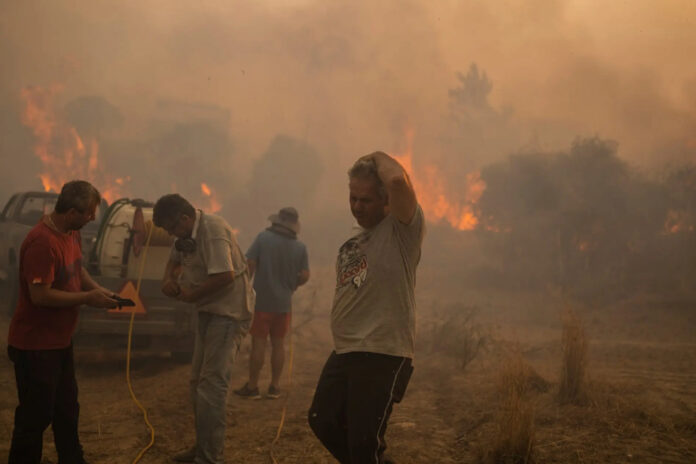As supermarket inflation slows in North America and Europe, three global risks are coming together in unprecedented ways to herald an era of high food price volatility, experts warn.
Three simultaneous calamities – extreme weather, Russian strikes on grain infrastructure in Ukraine and the rise of agricultural protectionism – are weakening the global food supply, making it less able to absorb disruptions.
“It’s the new normal: more volatility and unpredictability in commodity prices and food prices alike,” said Dennis Voznesenski, analyst at Rabobank in Sydney, Australia.
Even without major disruption, food prices fluctuate and many factors affect the price of a bushel of wheat or a loaf of bread.
In July, Russia withdrew from the Black Sea grain deal that allowed Ukrainian agricultural exports by ship. After months of decline, the United Nations food price index has rebounded, pushed by a jump in the price of vegetable oils and fears of a shortage of sunflower seeds from Ukraine.
Drought in India, Indonesia and other exporting countries in Asia led to reduced harvests. Rising prices have angered local consumers and governments have banned exports of key commodities, reducing global supply. Since late June, the Asian benchmark rice price has jumped 25%, according to the Thai Rice Exporters Association.
In America, other factors inflate the prices displayed at the grocery store. Faced with rising prices, workers are demanding wage increases. Furthermore, food producers find that in an inflationary environment, they can add to it and inflate their profits.
Since January 2020, the price of the grocery cart has increased by around 30% in Europe and 23% in the United States.
In 2023, bad weather affected food prices the most, says Hiral Patel, head of sustainable agriculture research at Barclays, London.
China suffered record heat waves, fires ravaged forests in Canada and the Mediterranean basin, and July 2023 was the hottest month on record globally.
In Pakistan, where catastrophic floods in 2022 washed away much of the harvest, the annual rate of food inflation reached 49% in May, according to the UN World Food Programme.
Earth could be entering a multi-year period of exceptionally warm weather due to CO2 emissions and the return of El Niño, a cyclical weather phenomenon, meteorologists predict.
The European Commission has just lowered its forecast for agricultural yields of soft wheat and spring barley due to “significantly drier than usual conditions” in large parts of Europe.
In July, Russian President Vladimir Putin let the Black Sea grain deal expire and his army destroyed grain warehouses in Ukraine. The price of wheat rose, dragging with it those of corn and soybeans. Consequently, the price of cereals could rise by 10 to 15%, estimates Pierre-Olivier Gourinchas, chief economist of the International Monetary Fund.
This is a significant jump, but less than the skyrocketing prices during the first weeks of the war. The global impact is less because Ukraine produces far less grain today. The country has also increased its capacity to export its cereals by rail and river. But these alternative routes cost more, and are not immune to Russian attacks or bad weather, says Mr. Voznesenski of Rabobank.
“You don’t know when a government is going to restrict its exports […] it’s going to create a lot more unpredictability,” he adds.
Price volatility has prompted some governments to restrict exports to conserve precious food resources.
In July, India, the world’s largest rice supplier, banned the export of non-basmati white rice. Last year, India imposed a 20% export tax on this rice, but exports have continued to increase due to geopolitical problems and extreme weather events in other countries, said the Indian government. According to the Food and Agriculture Organization of the United Nations, the price of rice increased by almost 20% in July compared to 2022; the rice price index is at a 12-year high.
India is not alone in doing so. According to Global Trade Alert, a Swiss non-profit organization, the number of restrictions or tax increases on food exports has increased by 62% since 2022. Globally, there are 176 such measures relating to food or fertilizer.
Economists and trade experts frown on these policies: they may protect local consumers in the short term, but they end up worsening global food shortages that governments are trying to alleviate.
At a recent UN food security summit in Rome, Ngozi Okonjo-Iweala, director-general of the World Trade Organization, urged countries to reject protectionism and liberalize trade to address shortages food.
For many countries, the problem is compounded by the low value of their currency against the US dollar, which prevents them from buying as many dollar-denominated commodities as before.
In addition to increased supply risks, food producers are seeing their related expenses increase. The price of the grocery basket is largely due to transport costs and other expenses borne by agribusinesses, which already have to pay more to produce wheat or sugar, for example.
Companies must take out insurance policies to deal with bad weather and finance the search for new suppliers to strengthen their activities.
As the drought has lowered water levels on important shipping lanes – including the Panama Canal and the Rhine – shippers have to lighten their loads or find alternative routes.
Finally, there is the cost of the green transition, for countries seeking to reduce their emissions. All in all, we see increased risk on the food supply, with prices and volatility to match.















